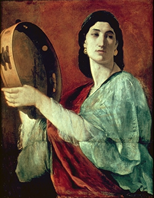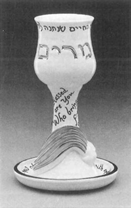
Like most religions, Judaism developed within a patriarchal society. Men recorded and interpreted religious law and wrote the traditional prayers and rituals. Jewish women in the twentieth century who strived for gender equality in the secular world faced a dilemma in reconciling their feminist outlooks with Jewish practice. How could they forge a Jewish religious identity consistent with contemporary values and gender equality?
The Passover Exodus story of oppression and liberation echoed women’s struggles. Like the Israelites, women wanted to step outside familiar subservient roles in society and attempt a riskier life of independence and responsibility. Thus, Passover became the ideal holiday to highlight past and present concerns about the inclusion and equality of women in Jewish traditions and community.
The first feminist Seder was organized by Esther Broner, Marcia Freedman, and Nomi Nimrod in Haifa in 1975. Inspired by this experience, Ms. Broner and Ms. Nimrod wrote The Women’s Haggadah, first used in New York and Haifa in 1976. Subsequently, women throughout the United States organized Seders, often composing their own text. New Haggadot have evolved from these feminist Seders, emphasizing the independence and strength of women and teaching about the unsung heroines of the biblical and rabbinic period.
Soon to follow were changes in prayerbook translations to be more gender inclusive as well as full participation of women in prayer services and Jewish rituals. Women also created new rituals.
In Philadelphia in 1978 a group of women celebrated Sukkot and decided to invite biblical women as guests (ushpizin) into their sukkah. The first guest was Miriam the Prophetess. After the women shared what they could learn from Miriam, they all drank a glass of water in honor of Miriam. Impressed by her experience, Penina Adelman created a Rosh Chodesh ritual honoring Miriam in her book: Miriam’s Well: Rituals for Jewish Women Around the Year (1990).
In Boston in 1989, a group of women met monthly to celebrate Rosh Chodesh. One month, Joyce Rosen led the others in a meditation of renewal from Mayim Chayim, the living waters of Miriam’s Well. Miriam’s Well is a magic well of water given to the Israelites in the desert that traveled with them in their Exodus from Egypt; it may have had magic curative properties as well as served as an important water supply in the dessert. It dried up upon Miriam’s death. The legend of Miriam’s Well provided a powerful metaphor for the role of Jewish women in sustaining the Jewish people, particularly in times of adversity.
Stephanie Loo Ratari, a member of the Boston Rosh Chodesh group, found the ritual so powerful that she placed a goblet of water in the middle of her Shabbat table and called it Kos Miryam. Each family member drank from the goblet as part of a new Shabbat ritual. Subsequently, the Boston Rosh Chodesh group made drinking from Miriam’s cup a part of their monthly meetings. It was a natural progression to use Kos Miryam as part of the Passover Seder, due to Miriam’s central role in the Exodus story.

In 1992, Lilith magazine commissioned potter Nissan Graham-Mayk to create a unique ritual object to serve as a Miriam’s Cup. The cup unfolds Miriam’s story as it rotates, including symbols for water and Miriam’s well as well as notes sparkling through Miriam’s tambourine. The magazine unveiled the first Miriam’s Cup along with a Miriam’s Cup Passover ritual written by Stephanie Loo Ritari, Matia Angelo, and Jenet Berkenfield. Blessings from this ritual encircle the stem and rim of the cup. Rabbi Susan Schnur wrote an accompanying article, tracing the history of Miriam from the Bible and Rabbinic commentaries to current feminist scholarship.
Year 2000 was the year of Miriam’s Cup! Many newspaper articles appeared about the new ritual of placing Miriam’s Cup on the Seder table. Needless to say, all the Judaica stores were eager to supply Miriam’s cups as a new Jewish ritual object! Miriam’s cup is filled with water rather than wine, to symbolize Miriam’s miraculous well. Typically all of the women at the Seder table fill the cup with water from their own glasses to signify the pivotal collective role of women for Jewish continuity. Various readings or prayers can be associated with Miriam’s Cup, often emphasizing the importance of nurturing and encouragement along our life’s journey.
